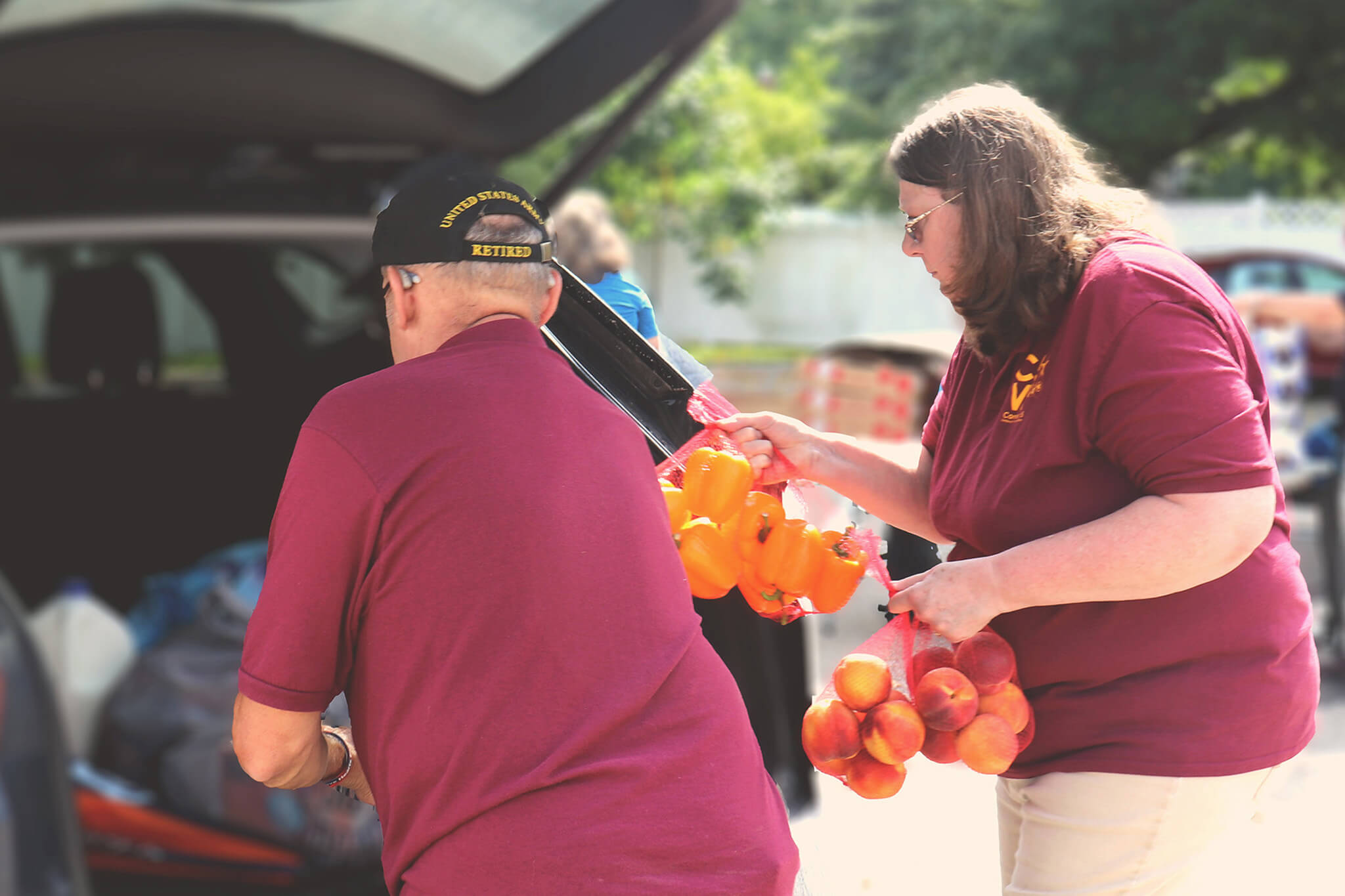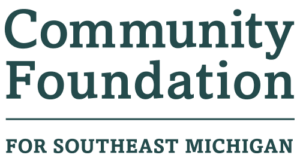
This story was first published in the Spring 2024 REPORT newsletter.
Can you envision a southeast Michigan where everyone has enough food to live an active, healthy life?
In this reality, no one would experience serious health struggles, increased absences from work or school, decreased attention for important tasks, or toxic stress resulting from sustained hunger and lack of nutrition. No older adult would have to choose between food and medicine. No parent would have to skip a meal so their child could eat.
Despite soaring food insecurity over the past few years, which has persisted into 2024, a future when our food system is equitable, sustainable and able to meet southeast Michigan’s needs is possible.
A safety net will always be needed, because there will always be emergency circumstances, even in the best economies. However, there are clear reasons to believe food insecurity is solvable. There’s a growing collective concern about the issue, coupled with a firm understanding of how to make food accessible. Addressing food insecurity also is more cost-effective than allowing it to persist, given food insecurity stresses our health care system, school districts and economy.
That’s why the Community Foundation for Southeast Michigan takes a multifaceted approach to food insecurity in the seven counties we serve. The Community Foundation supports nonprofits that meet emergency food needs, as well as innovative projects designed to increase food access, destigmatize food insecurity and provide education so individuals — and our entire region — can thrive.
Food insecurity can happen to anyone
The U.S. Department of Agriculture defines food insecurity as households that do not have access, at all times, to enough food for an active, healthy life for all household members.
In Michigan, nearly 12% of people face food insecurity, a figure that jumps to more than 13% among children, according to a Feeding America report released in 2021. However, these statistics don’t account for the consistent increases in food insecurity that food banks have observed since this data was collected, indicating the problem is more significant than these numbers reflect.
A Community Foundation-led analysis of combined data from the U.S. Census Bureau, State of Michigan and Feeding America, combined with press reports, also shows vast racial disparities, with the food insecurity rate among Hispanic households hitting 16% and Black households at 26% in 2021.
Nearly 13% of all U.S. households were food-insecure during 2022, the USDA reports, including more than 17% of households with children. These rates were “significantly higher” than the year before, according to the USDA, and were driven largely by the expiration of expanded COVID-19 nutrition benefits just as inflation ramped up. Many families are still struggling to recover financially from the pandemic, and the cost of living remains higher.
People might face food insecurity for many reasons, including:
- Systemic barriers: Lack of access to employment or pathways out of poverty can trigger food insecurity.
- Age: Food insecurity is more prevalent among children and seniors.
- Proximity to resources: Nationally, nine out of 10 counties with high food insecurity are rural.
- Short-term life disruptions: Health care issues, unexpected employment changes or the loss of a main wage earner, and alterations in access to housing or transportation also can drive food insecurity.
“While there are many misconceptions about food insecurity, one of the largest misconceptions is that only a certain population or type of person faces hunger,” says Katie Choate, senior director of Food Secure Livingston for Gleaners Community Food Bank, a Community Foundation partner. “Anyone, at any time, can face challenges in their lives that lead to food insecurity.”
For example, a woman named Angie recently picked up milk, fruits and vegetables for her young daughters from Gleaners. Inflation and rising food prices were already straining her family’s grocery budget when her husband, the family’s main provider, was hospitalized after a heart attack. Not working during his recovery meant lowered pay on top of added medical bills. As the family regains its footing, organizations like Gleaners help them fill the gap.
Community Foundation supports innovative programs
The Community Foundation has a long history with Gleaners as well as other nonprofits, including Forgotten Harvest and the Capuchin Soup Kitchen, that serve as emergency food providers. But, a recent grant to the Livingston County Hunger Council spotlights how the Community Foundation also supports innovative projects to increase food access, destigmatize food insecurity and provide education.
The Livingston County Hunger Council is a coalition of individuals, businesses and organizations committed to building a community-based food system. One of its committees, Mission Nutrition Livingston, used the recent Community Foundation grant to bring food to students who need it.
Mission Nutrition Livingston, in partnership with Gleaners Livingston, provides monthly mobile food distribution to families in the Fowlerville, Hartland, Howell and Pinckney school districts.
Participating families receive a meal package of fruits and vegetables, protein, grains and dairy, including fresh milk. Each package includes recommended recipes, and additional nutrition education opportunities are available. To overcome the stigma around food insecurity and encourage participation, all school district families are invited to take advantage of the service.
“This project features a truly collaborative approach to the problem of children in Livingston County going hungry, and addresses it with a very direct solution: Get nutritious food to the county’s youth as effectively as possible,” says Greg Yankee, senior director of Program at the Community Foundation. “With council members representing service agencies, school districts, county departments and a variety of other nonprofits, this is an example of mission-driven expertise and resources that have been combined to tackle an issue.”
The grant is one of many the Community Foundation has made to increase food access in southeast Michigan.
- Another example is support for Eastern Market’s expansion of its Farm Stand program. The program brings affordable fresh produce, grown by local farmers, to popup sites throughout neighborhoods in Detroit and Wayne County.
- Still another grant helped the nonprofit Make Food Not Waste prepare up to 4,000 high-quality, nutritious and culturally appropriate community meals each week in Detroit, all from food that otherwise would go to waste.
- The Community Foundation also has supported the Fair Food Network, which aims to grow community health and wealth through food. One grant to this organization boosted its Double Up Food Bucks program in southeast Michigan, which has since become a national model. The program provides a dollar-for-dollar match on the purchase of fresh produce for shoppers using the federal Supplemental Nutrition Assistance Program.
Collaboration is key to a brighter future
The Community Foundation for Southeast Michigan believes that every person, family and community should have access to the resources they need to thrive, and food is among the most vital.
Fortunately, food access can be improved by better coordinating support systems, enhancing existing programs and pursuing innovative practices to drive positive change. Central to this success is understanding people’s needs and fostering collaboration among partners within each community. No single entity can tackle the challenge of food insecurity alone.
“People, households and communities are stronger when hunger is solved,” says Gerry Brisson, president and CEO of Gleaners. “When we help people know where their next meals are coming from, they feel empowered to pursue other opportunities in life and (are able to) spend time on the things that are important to them because that worry is off the table. We’re giving our neighbors the opportunity to thrive.”
Food assistance demand still high
The demand for food assistance remains significantly higher than pre-pandemic levels due to inflation, higher costs of living, recent labor challenges, political uncertainty and changes to support programs.
Data from Gleaners Community Food Bank, a Community Foundation partner that served nearly 800,000 households during its fiscal year 2023 across a five-county area of southeast Michigan, provides a snapshot of this increased demand.
- Prior to fiscal year 2019*: Leading up to the COVID-19 pandemic, Gleaners distributed an average of approximately 40 million pounds of food across southeast Michigan annually.
- 2019: Including the beginning of the pandemic crisis, Gleaners provided nearly 46 million pounds of food to its service area.
- 2020: As the pandemic continued, Gleaners’ distributions increased dramatically to 64 million pounds.
- 2021: At the height of its pandemic support, Gleaners provided a record-breaking 71.4 million pounds over one year.
- 2022: As the pandemic crisis waned and food support programs ended, Gleaners still provided 47 million pounds of food to southeast Michigan.
- 2023: In its most recent fiscal year, Gleaners distributed more than 50 million pounds of food.
*Note: All years track with Gleaners’ fiscal year, which runs from October through September.
Source: Gleaners Community Food Bank
